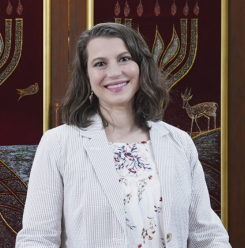As I write this, I am preparing to speak with my senator’s office staff along with other T’ruah chaverim to advocate for asylum seekers. I am fortunate that my senator has already made clear he will not be voting in favor of the two bills we are advocating against (S.1473, the Sinema-Tillis Bill, which seeks to expel anyone entering the U.S. without prior documentation, effectively banning asylum seekers, and S.1600, the Durbin-Peters Bill, which would implement militarized surveillance and security to the borders). I wish for blessing and strength for those of you who need to actively lobby for your elected officials to support human rights.
This week’s Torah portion, Parshat Shoftim, includes the commandments for Sanctuary Cities, so that “blood of the innocent will not be shed” (Deuteronomy 19:10). These “sanctuary cities” are different from the modern sense, as in sanctuary for immigrants from U.S. Immigration and Customs Enforcement (ICE) raids and deportation. Ancient Israel’s cities of refuge were places someone guilty of manslaughter could go to prevent being killed in violent revenge by a family member of the person they accidentally killed. It was a means of ensuring that true justice was served, not punishment based on personal vengeance. Whereas modern sanctuary cities protect against state violence, ancient sanctuary cities were a means of protection by the state against privatized violence.
Find more commentaries on Shoftim.
The Torah is full of commandments to welcome the stranger and to have one law for all residents, citizen and non-citizen alike, for “you were strangers in the land of Egypt.” The idea of needing protection against a state expulsion would be antithetical to our Torah values. Yet the Torah also constantly accounts for human flaws, thus necessitating further protections. In this way, the ancient sanctuary city that establishes a shelter against the human instinct for revenge is not so different from a modern sanctuary city, where a municipal or even state government may establish a shelter against the human instinct for xenophobia from the federal level. When understood through the modern lens of sanctuary for resident aliens, every city and town and village in the land of Israel is to be a sanctuary, a refuge for those fleeing any life-threatening danger.
Similarly, a self-proclaimed “melting pot,” a country that declared its independence by asserting that all men are created equal, should continue to be a sanctuary and refuge. The base of the Statue of Liberty, the beacon of hope of all that the United States has claimed to be, tells the world to “Give me your tired, your poor, Your huddled masses yearning to breathe free, The wretched refuse of your teeming shore. Send these, the homeless, tempest-tost to me, I lift my lamp beside the golden door!”
Lady Liberty no longer welcomes new Americans, and not just because they no longer come into New York Harbor on steamships. American history is unfortunately tainted by periods of non-welcoming — from the Chinese Exclusion Act of 1882 to the 1924 U.S. Immigration and Nationality Act, which was largely used in the 1930s and ‘40s to keep out Jews fleeing Nazi-occupied lands — and we are now in another such episode. While our current presidential administration has sought to distinguish itself from the previous regime, in actuality it has not implemented a more just or humane immigration policy. In fact, President Biden’s “Circumvention of Lawful Pathways” rule — an asylum transit ban — is having the effect of preventing vulnerable people from even asking for asylum. The humanitarian impact will be egregious and devastating.
Find more commentaries on Migrants and Refugees.
The point of the cities of refuge in Parshat Shoftim is to prevent ongoing cycles of violence. We are commanded to protect people from harm they do not deserve, even if they have also already harmed someone else by accident. How much more so should we be expected to protect people from harm they have done nothing to incur? Further, while the Torah names six sanctuary cities, Maimonides understands all 48 Levitical cities were to be sanctuaries (Hilchot Rotzeach 8:9), and that the priests and Levites in fact supplied food and shelter to the person seeking asylum. This suggests to me that we should still be expected to supply migrants and asylum seekers today with food and physical shelter. It is not enough to merely allow people in; we are also obligated to care for them and allow them to settle securely in their new homes, in the hopes of again stopping further cycles of crime or violence.
All manner of sanctuary cities, from the sort described in this parshah, to the legal status of municipalities refusing to cooperate with Customs and Border Patrol or ICE, to simply humane border checkpoints that welcome in the stranger, are for the purpose of pikuach nefesh, preserving life. May we soon see a day when every city, town, village, and border checkpoint in our nation is seen as a place of sanctuary.
Rabbi Lizz Goldstein was ordained by the Academy of Jewish Religion in 2016 and has been happily serving Congregation Ner Shalom ever since. She lives in Northern VA with her husband, cat, and guinea pig.

